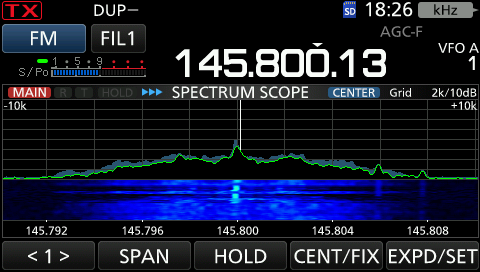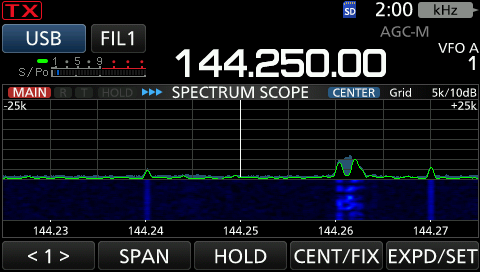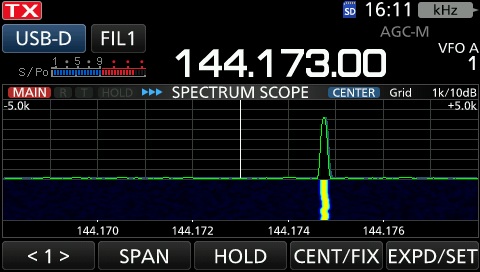With VHF simplex operation it’s all about finding the other stations for general communication, DXing, or contest QSOs, and there’s no better tool than a spectrum scope for finding those stations. Two great rigs with a built-in spectrum scope covering VHF are the IC-7300 for 6 meters and the IC-9700 for 2 meters, 70 centimeters, and 23 centimeters.
Spectrum Scope
I put those rigs to use in the ARRL January 2020 VHF Contest. You can find the details of my rover setup and operation at VHF Rover Contesting – Truly Moving QSOs. The spectrum scopes and similar operating controls across both rigs were huge during my rover run. It can get very busy during a contest and being able to catch a glimpse of a signal on the scope makes all the difference in finding stations and then getting them into the log. Having similar control setups between the rigs also helps minimize confusion when switching from one rig to the other – the touch screen on both rigs is very, very helpful.
IC-9700 VHF/UHF Rig
I’ve now used the Icom IC-9700 VHF/UHF All Mode Transceiver in VHF contests as a rover as well as from my home station for local activity nights and in a couple of tropospheric openings. Not only is it a super transceiver but the spectrum scope adds an entirely new dimension to your operating. Here’s how.
Finding Other Stations
As mentioned above, spotting other stations that are away from your receive frequency is a spectacular use of the IC-9700s spectrum scope. For example, the 2-meter SSB calling frequency is 144.200 MHz, so it’s good to monitor that frequency throughout a VHF contest. However, many stations will be operating around that frequency making calls or moving off the frequency to work another station. Being able to spot those calls can be immensely helpful.
While the 2 meter SSB calling frequency is typically the most important thing to monitor, the spectrum scope can allow you to switch bands to the 70 centimeter calling frequency, 432.100 MHz, and quickly get a feel for what’s going on within the band and, if nothing found, switch back to 2 meters.
Another helpful feature is the Scope SPAN setting. Here you can set it narrow, +/-2.5 kHz, or expand the amount of band that you’re monitoring up to +/-500 kHz. What I like about that is while I’m perhaps set up for WSJT-X FT8 at 144.174 MHz, with a wide setting on the spectrum scope I can see what’s happening at 144.200 MHz on SSB – or vice versa. The same holds true for other bands and even when trying MSK144 for meteor scatter on 144.150 MHz. The spectrum scope can greatly increase your awareness of what’s happening across the band.
Now in highly active areas, the high number of signals can be perhaps a bit overwhelming. In that case you’ll need to adjust your settings and how you watch the scope to maximize your efforts without becoming swamped with information.
Here in North Texas any activity at all can be news! Thus, you’re watching an essentially blank screen most of the time with any movement a good reason to tune to the station you’re seeing.
Verifying Correct Operation
One of the features of the spectrum scope that I really appreciate is viewing your transmitted signal. For this to work you’ll need to make sure that under SCOPE SET, you’ve turned “Scope during TX” to ON.
With this view you can readily see your transmitted spectrum. It’s particularly useful to make sure your WSJT-X FT8 signal audio level is set correctly. Too much and you’ll get splatter on your audio signal. This causes interference to other stations and may also make your own signal unreadable.
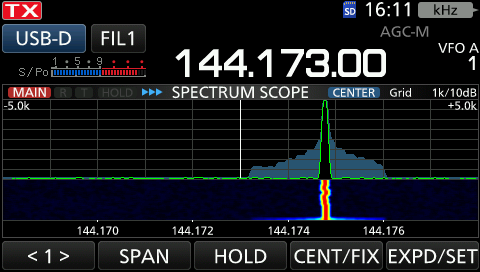
IC-9700 Spectrum Scope showing an FT8 signal with too high audio level during transmit. This is a very good way to determining correct operation using WSJT-X.
Spectrum Scope Setup
There are quite a few settings that you can adjust on the spectrum scope. I suggest spending some time tweaking with the colors, the line, etc. to find exactly the right combination that fits your eye and helps you readily find other signals.
At the top level menu you can set the span, either center or fixed mode, the reference level, the speed of the sweep and the marker that you use. In the SET mode you can set the type of display, the marker position, averaging, waveform type (I like fill + line), and you can make precise color adjustment for every part of the waveform.
In the past I’ve primarily used the center mode on the spectrum scope but a buddy pointed out the benefits of using the fixed mode. With this mode you can set the upper and lower frequencies and then move your operating frequency between them.
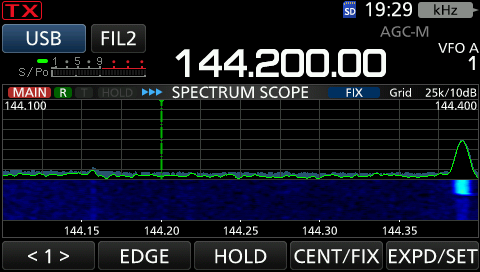
IC-9700 Spectrum Scope with the “fixed” setting – lower frequency 144.1 MHz, upper frequency 144.4 MHz. Note the APRS signal right at the upper limit.
The waterfall can be particularly helpful as it provides insight into signals over time. If you miss the station on the scope, you can see it receding off the screen in the waterfall. This too has a number of setting from speed, size, to color.
There are enough settings to keep you busy for a while finding the ones that work the best for your type of operating style and your personal preferences.
Spectrum Scope – Must Have Feature
It used to be that you could purchase a separate spectrum scope and add it to your station. Now the spectrum scope is an essential tool in your operating arsenal. The IC-9700 as well as the IC-7300 recognize that and provide one of the best scopes built in. Try it out.

